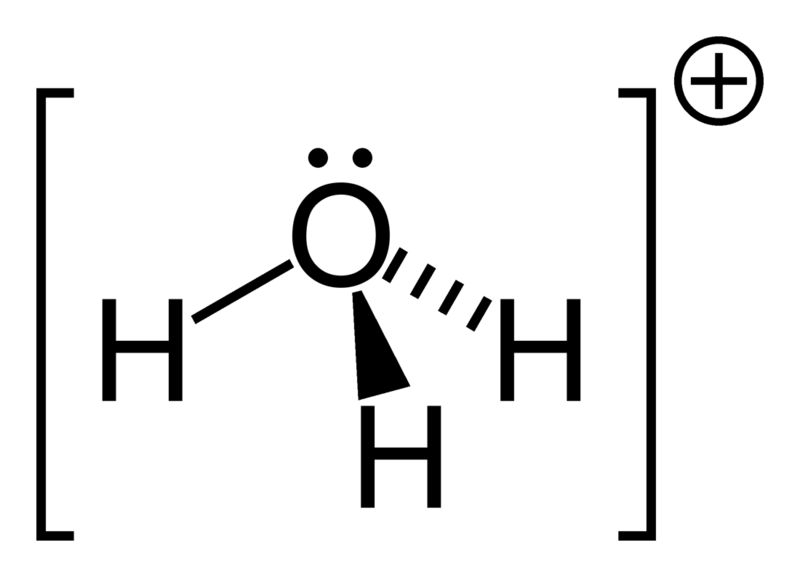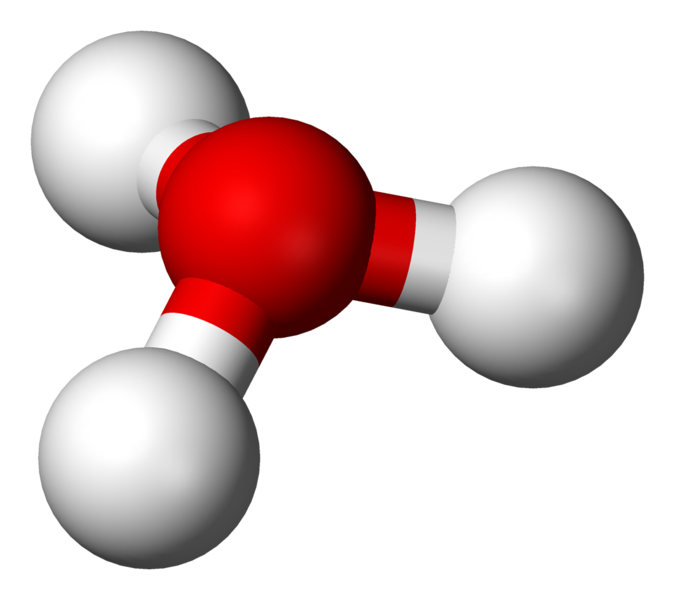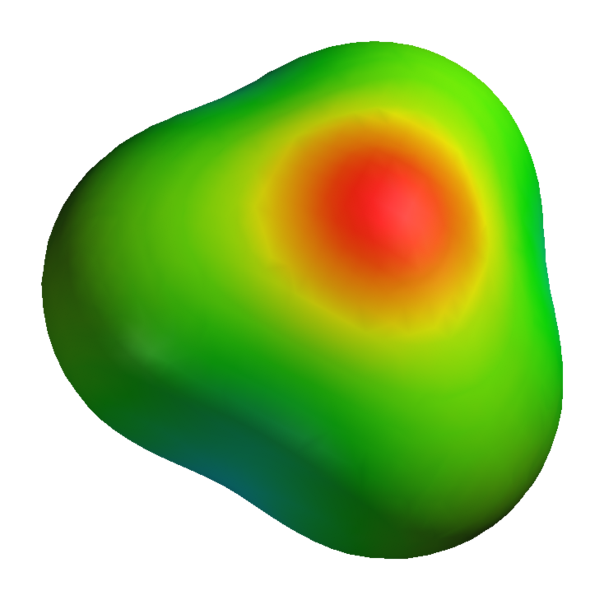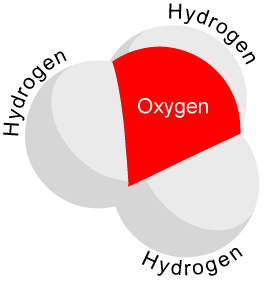Hydronium
| Template:Chembox header | Hydronium | |
|---|---|
   
| |
| Template:Chembox header | General | |
| Systematic name | hydroxonium |
| Other names | hydronium Ion |
| Molecular formula | H3O+ |
| Molar mass | 19.02 g/mol |
| Template:Chembox header | Properties | |
| Acid dissociation constant pKa |
−1.7 |
| Template:Chembox header | Except where noted otherwise, data are given for materials in their standard state (at 25 °C, 100 kPa) Infobox disclaimer and references | |
Editor-In-Chief: C. Michael Gibson, M.S., M.D. [2]
In chemistry, hydronium is the common name for the cation H3O+ derived from protonation of water. It is the simplest type of an oxonium ion.
Nomenclature
According to IUPAC nomenclature of organic chemistry, the hydronium ion should be referred to as oxonium. Hydroxonium may also be used unambiguously to identify it. A draft IUPAC proposal also recommends the use of oxonium and oxidanium in organic and inorganic chemistry contexts, respectively.
An oxonium ion is any ion with a trivalent oxygen cation. For example, a protonated hydroxyl group is an oxonium ion, but not a hydronium.
Acids and acidity
Hydronium is the cation that forms from water in the presence of hydrogen ions. These hydrons do not exist in a free state: they are extremely reactive and are solvated by water. An acid is generally the source of these hydrons; however, since water can behave as both an acid and a base, hydroniums exist even in pure water. This special case of water reacting with water to produce hydronium (and hydroxide) ions is commonly known as the self-ionization of water. The resulting hydronium ions are few and short-lived. (Nevertheless, they form the basis for determining the pH of basic aqueous solutions, since the less there are of these autoionized hydroniums, the more there is base.)
Hydronium is very acidic: at 25°C, its pKa is -1.7. It is also the most acidic species that can exist in water (assuming sufficient water for dissolution): any stronger acid will ionize and protonate a water molecule to form hydronium. The acidity of hydronium is the implicit standard used to judge the strength of an acid in water: strong acids must be better proton donors than hydronium, otherwise a significant portion of acid will exist in a non-ionized state. Unlike the hydronium that results from water's autodissociation, these hydronium ions are long-lasting and concentrated, in proportion to the strength of the dissolved acid.
The pH of a solution is a measure of its proton concentration. Since these protons react with water to form hydronium, the acidity of an aqueous solution is determined by its hydronium concentration.
Solvation
Researchers have yet to fully characterize the solvation of hydronium ion in water, in part because many different meanings of solvation exist. A freezing point depression study determined that the mean hydration ion in cold water is approximately H3O+(H2O)6 [1]: on average, each hydronium ion is solvated by 6 water molecules which are unable to solvate other solute molecules.
Some hydration structures are quite large: the H3O+(H2O)20 magic ion number structure (called magic because of its increased stability with respect to hydration structures involving a comparable number of water molecules) might place the hydronium inside a dodecahedral cage [2]. However, more recent ab initio molecular dynamics simulations have shown that, on average, the hydrated proton resides on the surface of the H3O+(H2O)20 cluster[3]. Further, several disparate features of these simulations agree with their experimental counterparts suggesting an alternative interpretation of the experimental results.
Two other well-known structures are the Zundel cations and Eigen cations. The Eigen solvation structure has the hydronium ion at the center of an H9O4+ complex in which the hydronium is strongly hydrogen-bonded to 3 neighbouring water molecules [4]. In the Zundel H5O2+ complex the proton is shared equally by two water molecules [5]. Recent work indicates that both of these complexes represent ideal structures in a more general hydrogen bond network defect [6].
Isolation of the hydronium ion monomer in liquid phase was achieved in a nonaqueous, low nucleophilicity superacid solution (HF-SbF5SO2). The ion was characterized by high resolution O-17 nuclear magnetic resonance.[7].
In 2007, Markovitch & Agmon have calculated for the first time ever the enthalpies and free energies of the various hydrogen bonds around the hydronium cation in liquid protonated water[8] at room temperature and discussed the implementation for the proton hopping mechanism. Using molecular dynamics they were able to show that the hydrogen-bonds around the hydronium ion (formed with the three water ligands in the first solvation shell of the hydronium) are quite strong compared to those of bulk water.
Solid hydronium salts
For many strong acids, it is possible to form crystals of their hydronium salt that are relatively stable. Sometimes these salts are called acid monohydrates. As a rule, any acid with an ionization constant of 109 or higher may do this. Acids whose ionization constant is below 109 generally cannot form stable H3O+ salts. For example, hydrochloric acid has an ionization constant of 107, and mixtures with water at all proportions are liquid at room temperature. However, perchloric acid has an ionization constant of 1010, and if liquid anhydrous perchloric acid and water are combined in a 1:1 molar ratio, solid hydronium perchlorate forms.
The hydronium ion also forms stable compounds with the carborane superacid H(CB11H(CH3)5Br6) [9]. X-ray crystallography shows a C3v symmetry for the hydronium ion with each proton interacting with a bromine atom each from three carborane anions 320 pm apart on average. The [H3O][H(CB11HCl11)] salt is also soluble in benzene. In crystals grown from a benzene solution the solvent co-crystallizes and a H3O.(benzene)3 cation is completely separated from the anion. In the cation three benzene molecules surround hydronium forming pi-cation interactions with the hydrogen atoms. The closest (nonbonding) approach of the anion at chlorine to the cation at oxygen is 348 pm.
See also
Hydronium is the name of a video game engine based on DirectX 9 created by Julien Delmotte in 2006.
References
- ↑ Zavitsas, A. A. (2001) Properties of water solutions of electrolytes and nonelectrolytes. J. Phys. Chem. B 105 7805-7815.
- ↑ Hulthe, G.; Stenhagen, G.; Wennerström, O. & C-H. Ottosson, C-H. (1997) Water cluster studied by electrospray mass spectrometry. J. Chromatogr. A 512 155-165.
- ↑ Iyengar, S. S. ;Petersen, M. K.; Burnham, C. J.; Day, T. J. F.; Voth, G. A. (2005) The Properties of Ion-Water Clusters. I. The Protonated 21-Water Cluster. J. Chem. Phys. 123 084309.
- ↑ Zundel, G. & Metzger, H. (1968) Energiebänder der tunnelnden Übershuß-Protenon in flüssigen Säuren. Eine IR-spektroskopische Untersuchung der Natur der Gruppierungen H5O2+ Z. Phys. Chem. 58 225-245.
- ↑ Wicke, E.; Eigen, M. & Ackermann, Th. (1954) Über den Zustand des Protons (Hydroniumions) in wäßriger Lösung. Z. Phys. Chem. 1 340-364.
- ↑ Marx, D.; Tuckerman, M. E.; Hutter, J. & Parrinello, M. (1999) The nature of the hydrated excess proton in water. Nature 397 601-604.
- ↑ Mateescu, Gheorghe D. & Benedikt, George M. (1979) Water and related systems. 1. The hydronium ion (H3O+). Preparation and characterization by high resolution oxygen-17 nuclear magnetic resonance. Journal of the American Chemical Society , 101(14), 3959-60.
- ↑ Structure and energetics of the hydronium hydration shells. Omer Markovitch and Noam Agmon J. Phys. Chem. A; 2007; 111(12) pp 2253 - 2256; [1]
- ↑ The Nature of the H3O+ Hydronium Ion in Benzene and Chlorinated Hydrocarbon Solvents. Conditions of Existence and Reinterpretation of Infrared Data Evgenii S. Stoyanov, Kee-Chan Kim, and Christopher A. Reed J. Am. Chem. Soc.; 2006; 128(6) pp 1948 - 1958; Abstract
da:Hydronium de:Oxonium ko:옥소늄 이온 he:הידרוניום mk:Хидрониум nl:Oxonium